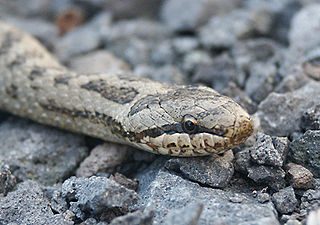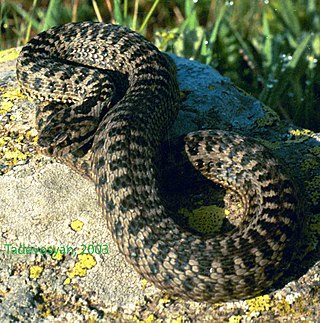
Aspidites is a genus of pythons endemic to Australia. The name can be translated as "shield bearer" and pertains to the symmetrically shaped head scales. Currently, two species are recognized.

The smooth snake is a species of non-venomous snake in the family Colubridae. The species is found in northern and central Europe, but also as far east as northern Iran. The Reptile Database recognizes two subspecies as being valid, including the nominotypical subspecies described here.

Tantilla melanocephala, commonly known as the black-headed snake or neotropical black-headed snake, is a species of small colubrid snake endemic to Central America and South America.

The black-headed python is a species of snake in the family Pythonidae. The species is endemic to Australia. There are no subspecies that are recognized as being valid.

The Caucasian agama is a species of agamid lizard found in the Caucasus, E/S Georgia, Armenia, Azerbaijan, Turkmenistan, Tajikistan, Dagestan (Russia), E Turkey, Iraq, N Iran, Afghanistan, NW Pakistan, and parts of Kashmir.

Macrovipera lebetinus, known as the blunt-nosed viper, Lebetine viper, Levant viper, and by other common names, is a viper species found in North Africa, much of the Middle East, and as far east as Kashmir. Like all other vipers, it is venomous. Five subspecies are currently recognized, including the nominate race described here.

The streaked kukri snake is a species of nonvenomous snake found in Asia. It is also known as the variegated kukri. The IUCN lists the species as least concern.

The checkered keelback, also known commonly as the Asiatic water snake, is a common species in the subfamily Natricinae of the family Colubridae. The species is endemic to Asia. It is non-venomous.

Ophisops elegans, commonly known as the snake-eyed lizard, is a species of lizard in the family Lacertidae. The species is endemic to the Mediterranean region and Central Asia. There are nine recognized subspecies.

Hydrophis melanocephalus, commonly known as the slender-necked sea snake, is a species of venomous sea snake in the family Elapidae.

Macrovipera, known as the large Palearctic vipers, is a genus of vipers that inhabit the semideserts and steppes of North Africa, the Near and Middle East, and the Milos Archipelago in the Aegean Sea. Like all other vipers, they are venomous. These snakes are responsible for a number of bites in Africa and Western Asia every year. They have a reputation for being ill-tempered and can inject a lot of venom, which is why they should be considered as very dangerous. Two species are currently recognized.

Vipera darevskii, known as Darevsky's viper, is a small species of viper, a venomous snake in the subfamily Viperinae of the family Viperidae. The species is native to northwestern Armenia, northeastern Turkey, and possibly also adjacent southern Georgia. There are no subspecies that are recognized as being valid.

The horseshoe whip snake is a species of snake in the family Colubridae. The species is native to southwestern Europe and northern Africa.
Melanocephalus is an epithet often used as the second word of a binomial name. It derives from Greek words meaning 'black-headed'. It is used in the names of the following species:

Phrynocephalus persicus, commonly known as the Persian toad-headed agama, is a small diurnal desert lizard of the family Agamidae. It is the westernmost representative of the Central Asian genus of toad-headed agamas Phrynocephalus and is only known from deserts and semideserts of Iran and possibly Azerbaijan.

Rhynchocalamus is a genus of snakes in the family Colubridae.
Oligodon annulifer, also known as the ringed kukri snake, is a colubrid snake endemic to the island of Borneo.
Muhtarophis barani, also known commonly as Baran's black-headed dwarf snake, is a species of snake in the monotypic genus Muhtarophis in the subfamily Colubrinae of the family Colubridae. The species is endemic to the Amanos Mountains of Turkey, and was discovered in 2007.
Oligodon hamptoni, also known commonly as Hampton's kukri snake, is a species of snake in the subfamily Colubrinae of the family Colubridae. The species is native to southern Asia.

Rhynchocalamus satunini, the Palestine kukri snake, is a species of snake of the family Colubridae.














